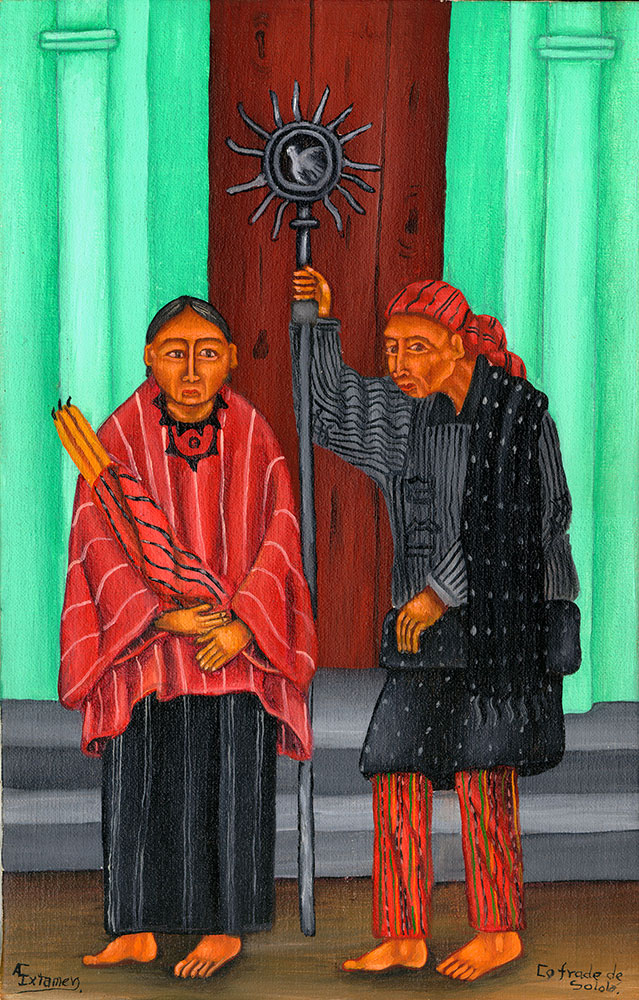
Cofrade de Sololá
(Officials of the Cofradia in the town of Sololá)
1988
16" x 10", oil on canvas.
Antonio C. Ixtamer
Bought in a gallery in Santiago Atitlan
This is the earliest painting by Antonio Ixtamer in the collection. It was probably painted in the last part of 1988. Ixtamer could not have been painting on his own for more than about a year, but this painting clearly demonstrates his what will emerge as one of his major strengths: that as a colorist. He limits his palette to three main colors—turquoise, red, and black. The subject is a man and woman who are members of a Cofradia, a religious fraternity, in the town of Sololá, standing in front of the steps of what appears to be a church building. Both the man and the woman carry emblems of their membership in the cofradia, the woman carries long candles wrapped in cloth, and the man carries a silver staff The clothe tz’ute he wears on his head is also a symbol of his office. Since they are both barefoot, it would seem that this painting is of an earlier time when not everyone had shoes. It might also be that the long blouse, or huipil that the woman wears is of an earlier time, for the ones I am familiar with have more colored embroidery. All the rest of their traje is typical of Solola..
I bought this painting in a small gallery behind other stores in Santiago Atitlán. I remember that the walls were filled with hundreds of small paintings, none much larger than this. Most of the paintings were terrible, but I found a handful of paintings I liked and they all were painted by Ixtamer. I have long regretted buying only one of them. When I finished paying the owner for the painting, he asked if I wanted to meet the artist. It turns out Ixtamer had just brought the paintings to the gallery to sell, and had watched as I chose one of his paintings. This was my second meeting with Antonio Ixtamer, I had met him a year before, while he was a student of Pedro Rafael Gonzalez Chavajay.
The frame of this painting was the most difficult frame in the entire collection, not to make but to decide how to make it so it would not diminish a the special qualities of the painting. The first frame was a blackish walnut to match the back in the clothes of the cofradistas, but it closed off the expansive quality of the upper part of the painting making the painting seem less. Therefore, a second frame was constructed of mahogany, the brown color matching the brown of the church door. It also closed off the top of the painting and was also rejected as a frame. I loved this little painting and left it and the second frame which had been removed near my bed so I could think about how to frame it. One morning I got up and realized one thing I really liked about the painting was that the color in the upper part went out the upper corners. I thought I could paint the frame the same color as the church, extending the lines of the painting, and in this manner a frame would not confine the painting. It was a success and is the most noticed frame in the collection. It is so integral to the painting that many people think it was made by the artist.
Exhibited:
Arte Americas, Fresno, CA, May 4 to July 13, 1997
Museo Chicano, Phoenix, AZ; February & June 25—Aug 7, 1998
SOMART Gallery, San Francisco, CA; Jan. 4—22, 2000